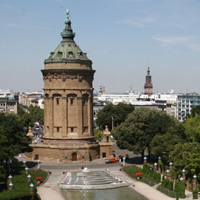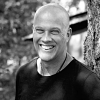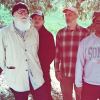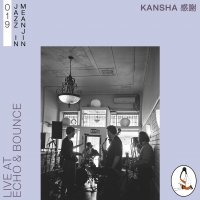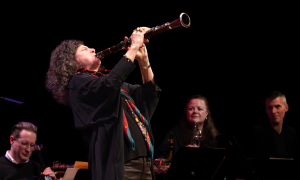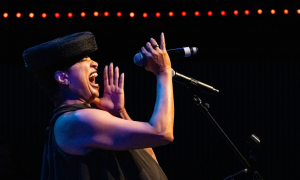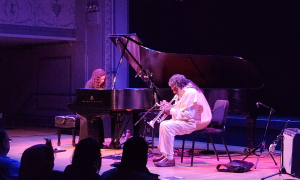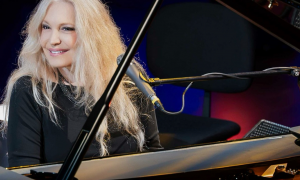Home » Jazz Articles » Live Review » Enjoy Jazz Festival: Days 7-10, October 26-29, 2009
Enjoy Jazz Festival: Days 7-10, October 26-29, 2009
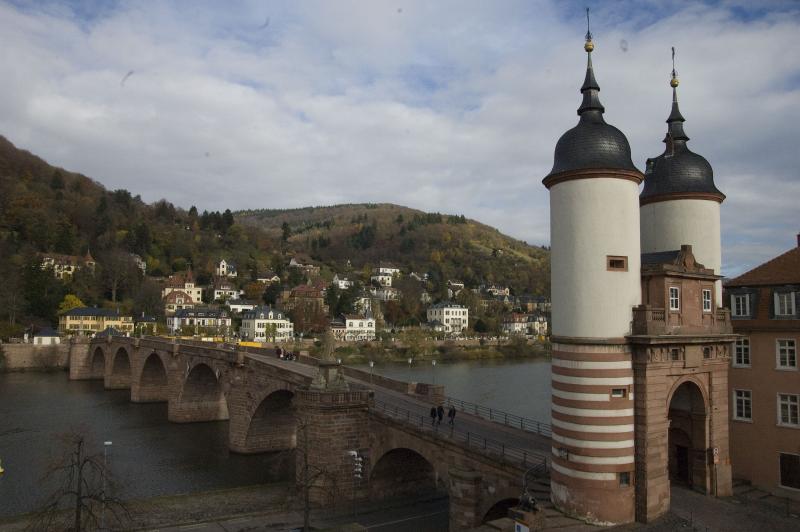
The main purpose of visiting the Heidelberg/Mannheim/Ludwigshafen region may be for the music, but during the day there's plenty to see and do. Wandering around the old part of Heidelberg, it's difficult not to be moved by the profound sense of age, especially coming from the much younger North America. Heidelberg has, to be sure, a more modern section, but Old Heidelberg manages to successfully maintain a quaint feeling in its cobblestoned roads, numerous cathedrals and modern amenities couched within the older structures. With narrow roads—often almost impossible to navigate, even on foot, with cars parked on both sides—there's a relaxed vibe, despite being populated by a community that pays great attention to detail...and punctuality.
For a city that boasts so much despite its relatively small population (under 150,000), there's a wealth of cultural activities throughout the year, with Enjoy Jazz rising rapidly over its now eleven years, to become Germany's largest jazz festival. As the festival continues towards its end on November 11, the four days following the ECM 40th anniversary were devoted to a number of prominent American musicians, ranging from guitarist Bill Frisell's 858 Quartet and pianist Brad Mehldau to Jimmy Cobb's Kind of Blue at 50 tribute band, and singer Cassandra Wilson. From the mainstream to the gently experimental, it was further evidence of the festival's exceptionally broad stylistic purview.
Chapter Index
- Visiting Heidelberg
- Bill Frisell 858 Quartet
- Brad Mehldau Solo
- Jimmy Cobb's So What Band: Kind of Blue at 50
- SAS Enjoys Jazz
- Cassandra Wilson
- Bill Frisell 858 Quartet
Visiting Heidelberg
A series of open marketplace squares act as focal points throughout old Heidelberg, with cafés, stores, markets and hotels. It's a popular tourist destination, yet there's never a feeling of overcrowding. A leisurely walk down Castle Hill, home of Heidelberg Castle, is an opportunity to relax and experience some beautiful scenery, including views of Heidelberg and beyond from various points on the 90-minute journey.
In addition to its beautiful old bridge crossing the Neckar River, the immense and impressive Heidelberg Castle is considered the greatest ruin this side of the Alps. Beginning life as a fortress and taking over 200 years to build (completed in 1619), the castle was destroyed and rebuilt three times—first in the infamous Thirty Years' War, and finally ravaged by fire in the 1700s (the interior of many parts of the castle possess solid wood ceilings in addition to floors and wall, so was highly combustible) and ultimately left to ruin.
Traveling to the castle by funicular—switching to another, 100 year-old funicular above the castle leads to the top of Castle Hill for a spectacular view of Heidelberg and beyond—a tour of the castle reveals a great deal about life in the 17th and 18th century. With an average life expectancy of 35, paintings of some of the castle's Prince Electors (a collective of seven elected Germany's king) are deceptive, as these portraits give a false impression of men in their fifties who are, in fact, in their late teens or early twenties.
Ceramic stoves in the castle's large rooms did little to keep the structure warm during the long winters, as stone walls, often meters thick, relentlessly retained the cold. What appear to be small doors in the hallways were, in fact, conduits for servants—who were not allowed in the main rooms—to surreptitiously add wood to the stoves. With unclean water a constant threat of disease, wine was the preferred drink—and a huge barrel that holds tens of thousands of liters is a reminder of just how much was consumed, though the alcohol content was much less than is common today.
Rooms filled with large wooden furniture, an old apothecary, and outside walls peppered with tremendous statues, archways and centuries-old vine, Heidelberg Castle is an experience not to be missed.
Demonstrating a commitment to reducing carbon footprint that is absolutely a case of "walking the walk," it's possible to take a trip up the Neckar River on a solar shuttle—a metal boat that can accommodate up to 110 people, powered entirely by solar panels that store energy in large batteries, allowing the boat to both run silently and in the evening.
The short trip provides an opportunity to capture the scenic beauty of Heidelberg, nestled in the Neckar Valley. Drawing attention to the Natural Sciences building of the centuries-old University of Heidelberg, the boat's narrator pointed out that the reason it was impossible to find a specific campus is because all of Heidelberg is the campus, with buildings peppered throughout the city. With over 25,000 students—responsible for a sixth of the city's population, the university has been a renowned scientific center for centuries.
Heidelberg is an idyllic destination where old and new comfortably intersect, with a pervasive sense of history and significance that's impossible to ignore.
Bill Frisell 858 Quartet
Despite being named after his more extreme Richter 858 (Songlines, 2005), Bill Frisell's 858 Quartet performance at Ludwigshafen's dasHaus leaned more towards the Americana that's occupied much of the influential guitarist's interest over the past several years. Culling material from History, Mystery (Nonesuch, 2008), Frisell nevertheless brought some sharper angles and rough surfaces to the material, some of which he's been mining for several years, and dating as far back as the set opener, bluesy, ambling "Monroe," first heard on Good Dog, Happy Man (Nonesuch, 1999) and the quirky "Rag," from Is That You? (Elektra/Nonesuch, 1990).
Surrounded by longtime musical friends and partners—cellist Hank Roberts, who was a member of Frisell's first touring band; violist Eivind Kang who first worked with the guitarist alongside 858's fourth member, trumpeter Ron Miles, on the equally curiously configured Quartet (Nonesuch, 1997)- -Frisell's group was the definition of chamber jazz. Performing so quietly that photographers were asked not to take photos near the stage as the clicks of the cameras would be too loud, there were, in fact, no monitors—only Frisell's two amplifiers and mikes on the other instruments in order to get sound out to the house. The intimacy amongst the four players, collected tightly together at the center of the stage to maximize eye contact, made for a 100-minute set that often flowed from tune-to-tune with a kind of comfortable dissolve into free play, oftentimes amorphous, yet always managing to lead to the next piece.
If ever there was a collection of under-rated players it's this one, with the obvious exception of Frisell, who has been an incredibly loyal musical partner throughout his own rapid rise to fame. Sure, he's played with Elvin Jones, Dave Holland and Ron Carter; but when he needs a trumpeter, Miles is invariably the first call—and a terrific choice. Capable of acting as an accompanist in addition to rising to the top to layer tart lines, he was an incredibly intuitive player with a similarly curious musical wit that made him an ideal foil for Frisell's often quirky, comical turns. Kang was a versatile player who, with the richer, lower register viola, was at times a rich contrapuntal partner, other times supporting the slowly evolving music. Roberts, perhaps the most undervalued of them all, was outstanding, whether he was walking bass lines during what sounded like a curious rendition of John Coltrane's change-heavy "Giant Steps," improvising freely in the connecting passages, or delivering bluesy lines on History, Mystery's roots-meets-world-music "Baba Drame," first heard on The Intercontinentals (Nonesuch, 2003).
As for Frisell, a man who may hold the banner for "most humble guitarist in jazz," he was clearly having a great time playing with old friends in a relaxed environment where the written material was nothing more than a means to allow the quartet to go where it wanted. As always, a variety of effects and looping devices allowed him to stretch the sound of his guitar, and between songs he kept triggering a brief snippet of near-white noise, looking to his band mates with a mischievous grin.
There are those who accuse him of overworking a repertoire and, given the considerable cross-over with his 2009 performance at the Montreal Jazz Festival—though that was a more conventional line-up, with Miles, longtime bassist Tony Scherr and relative newcomer/drummer Rudy Royston—it's certainly true that, despite new albums with a preponderance of fresh material every year, Frisell continues to return to a smaller subset of songs. But Frisell feels that he's still exploring these songs' greater potential and, based on these two 2009 performances, there's every indication that there's still plenty of possibility. Without a drummer, the 858 Quartet grooved in a different way through Frisell's often repetitive structures, as opposed to his Montreal group. But groove it did, and explore and interact on the most intimate of levels.
It was the gentlest kind of free music, where there was enough structure for Frisell, Roberts, Kang and Miles to provide context, but with complete latitude to go where the collective mind wanted. Proof that free improvisation needn't be unapproachable, Frisell and the 858 Quartet played with the kind of unassuming honesty, deep feeling and playful sense of humor that could only draw in the sold-out audience.
Brad Mehldau Solo
If there was but a single lesson learned at Enjoy Jazz's four-day ECM 40th anniversary celebration, which ended two evenings ago, it was this: less is, indeed, often more. As prodigious a talent as pianist Brad Mehldau is, it's a lesson he could have applied to his heavily attended solo performance at the beautiful Christuskirche in Mannheim, on October 27, 2009.
Unlike many young artists who come to public attention too soon, Mehldau's meteoric career has been completely supported by a discography of almost unparalleled strength, demonstrating equally swift evolution over the course of his five Art of the Trio Warner Bros. releases from 1997 to 2001, and growing even further on more recent releases including House on Hill (Nonesuch, 2006) and Live (Nonesuch, 2008), with his longstanding trio. With Live in Tokyo (Nonesuch, 2004) a thoroughly compelling live solo disc, expectations were high for his Mannheim appearance.
While comparisons to the late Bill Evans were, even early in his career, always superficial at best, at this point Mehldau's voice is so completely defined to render meaningless any such references. If any comparison can be drawn, it would be to Keith Jarrett's legendary stream-of-consciousness solo performances; but whereas Jarrett pulls much from nothing, Mehldau starts with song form, though where his improvisations go is often anybody's guess. Mehldau has always combined his own writing with a healthy reverence for jazz standards and interpretations of contemporary sources, but his Mannheim show drew more decidedly from artists including Radiohead, Nick Drake, Nirvana and Massive Attack than ever before.
It started with great promise, as Mehldau opened with a demonstration of remarkable skill while, at the same time, avoiding the chops-laden excesses of most performers with his advanced technique. Mehldau can truly do more with one hand than most pianist's do with two, and with a set of simple changes, Mehldau grew the song organically and with inexorable logic. From a spare, one-handed arpeggio, a simple melody grew from his right hand, as he explored the keyboard both above and below his left. With relentless inevitability, it grew increasingly dramatic, with a kind of minimalistic repetitiveness—breathtaking and as distinctive an approach as can be found amongst modern jazz pianists. Few explore the lower register as thoroughly as Mehldau does—with the possible exception of Paul Bley—and it created an immense sound that resonated throughout the cathedral.
Turning even more economical, Mehldau created a thing of spare beauty as even simpler changes supported greater lyricism and some attention to space. But that's where the set began to get into trouble. From that point forward, Mehldau seemed fixated on interpreting the material in much the same fashion. Changes asserted by the left hand led to a right that gradually built to mirror its partner, as a relentless eight-or- sixteenth-note pulse built to a climax to be sure, but ultimately, song-after-song, became too similar. It's one thing to have a unique approach; another to be so singular with it that there's too little variation. Again, Mehldau's technique was impeccable, as he reversed roles and soloed with his left hand, maintaining the changes and harmonic context with his right; few pianists in jazz possess this kind of remarkable ambidexterity.
It was a distinctive enough style, but one that rarely let the music breathe. If less is more, then certainly more is not more. Mehldau's undeniable talent, sometimes underlined by excessive cerebralism, would have been far more effective if, as on his own Live in Tokyo, he'd introduced both a little more variety and a lesser preponderance for filling every possible nook and cranny. All the more disappointing because Mehldau has always been so predictably superb, it can't be called a bad show, but it was one that failed to deliver on expectations built around past performances and his impressive discography.
The audience was, however, largely beyond appreciative, leading to one final issue with Mehldau's show. It's always a good thing to leave an audience happy but hungry for more, and by satisfying the audience's continued demands, by the time Mehldau had finished his fourth encore, the applause went from being thunderous—as unrelenting as his performance—to quickly dying out. One encore is usually enough; two, recognition of a particularly enthusiastic audience. More than that and it becomes a case of diminishing returns. All leading to the feeling that, while Mehldau's performance was one that might be difficult to match in matters of technique, lacked the inherent musicality of pianists like Stefano Bollani, Bobo Stenson, Jarrett...and even himself, as Live in Tokyo and Elegiac Cycle (Warner Bros., 1999) amply demonstrated.
Jimmy Cobb's So What Band: Kind of Blue at 50
The final surviving member of the sextet responsible for Miles Davis' classic Kind of Blue (Columbia, 1959), drummer Jimmy Cobb has been fighting the good fight to not just keep the music alive with his So What Band and the "Kind of Blue at 50" tour that's been going on throughout 2009, but making sure that it does so in a way that's as relevant today as it was half a century ago. With pianist Larry Willis, alto saxophonist Vincent Herring, tenor saxophonist Javon Jackson and Miles protégé Wallace Roney on trumpet, the set was identical to that of the group's performance four months ago at the Ottawa International Jazz Festival. But with Buster Williams back onboard (he was subbed out in Ottawa due to illness), the sextet's October 28, 2009 performance at BASF's Feierabendhaus in Ludwigshafen was an even more powerful set, driven by the bassist's resonant sense of swing.
BASF may be less visible than in years past—the days of BASF Chromium Dioxide cassette tapes now a thing of the distant past—but it's still a major player that manufactures products that are a part of other more visible ones from other manufacturers. Most remarkable is that the company, which has been around for over 80 years, is not just the primary employer in Ludwigshafen, but employing 32,000 of a population of 130,000 people, it's literally the city's raison d'être. Few technology companies can boast a cultural department period, let alone one that, consisting of five musicians and one artist, puts on over sixty shows every year in its own venue. A sponsor as well as a promoter (one of Enjoy Jazz's largest, in fact), it's even more unusual that the only concerts that go on in the company's Feierabendhaus are those that it promotes; it's not even possible for an outside party to rent the hall.
With Cobb's packed show taking place in the venue's 1,300-seat main hall (the other room, with a capacity of 250, is for smaller chamber music events), it was one of a relative few jazz performances that take place at the venue, with the majority of the shows at Feierabendhaus devoted to classical music. Still, the sound in the room, as has been the case with literally every venue at Enjoy Jazz so far, was impeccable, as the band took to the stage with a version of Miles' enduring "So What," taken at a faster clip than on the iconic album. There have been—and, no doubt, will continue to be—plenty of tribute projects since Miles' death in 1991, but few attain the level of veracity that Cobb's has, even while the players are far from imitative, each bringing their own voice to a set that, in addition to running down the album, added a couple of extra tunes including a lovely reading of the classic standard, "On Green Dolphin Street" (originally performed by Miles' sextet on Jazz Track (Columbia, 1958)), a feature for Roney's plangent horn.
Every song featured solos that went from strength to strength, but with this a Miles tribute band, perhaps the player receiving the most scrutiny was Roney, as his Ottawa performance demonstrated—not to mention a series of envelope-pushing albums such as Prototype (HighNote, 2004) and the daring yet aptly-titled Jazz (HighNote, 2007)—Roney is hardly a Miles imitator; instead, using the late trumpeter as a starting point, he's gone on to create a clear voice that's equally rich in tone, but possessing of greater range. Eschewing the Harmon mute that was such a definitive part of Miles' emotionally fragile sound, Roney instead chose to use a pure, unaltered tone, even on the tranquil "Flamenco Sketches."
Williams was another standout amongst a group of consistently fine players. Surprisingly diminutive in stature, he remains an influential bassist with a tone that's resonant and visceral, felt deep in the gut when he created long glissandi and lightning fast phrases during his solos, anchoring the group with a rare rhythmic sense that made him the ideal player to succeed Kind of Blue's Paul Chambers here. As for Cobb, he soloed rarely, but more than his brief features, his firm pulse and outstanding dynamics were what made him such a valued part of Kind of Blue and beyond. His transition from brushes to sticks, introducing the solo section of "So What," is still shiver-inducing, and he says more than most with no more than quarter notes on a ride cymbal.
Mainstream jazz sometimes gets a bad rap as reductionist and backward these days, rather than forward- thinking and modernistic. But with material so ingrained in the psyche of most jazz fans that it's a part of their DNA, and with a group of players that honor the spirit rather than the letter of their source material, Cobb and his So What Band kept the force alive with attitude and commitment.
SAS Enjoys Jazz
In addition to the support that Enjoy Jazz receives from BASF, SAS—one of the world's leading vendors of business software—has been providing substantial support to the festival for the past five years. Meeting with Thomas Maier, Corporate Communications Manager, at Haarlass, SAS' German headquarters located across the Old Heidelberg Bridge on the other side of the Neckar River, it was immediately clear just how differently the company views both corporate responsibility and treatment of its employees. With a head office that used to be an old hotel where rooms are named after famous visitors like Mark Twain, it's as far removed from the typical glass business towers of North American business as one is apt to find. "Corporate/social responsibility is a big part of SAS," said Maier. "It starts with our buildings, which are built with the latest environmental standards. We take care of our employees: we have fitness centers, a big education pool, a health program, kindergarten; all these things."
Progressive? Certainly. With a cafeteria facing the Neckar River, a beer garden where, during the summer, roses bloom and large trees provide shade, it's possible to work as there's WIFI access everywhere. "Maybe," Maier continued, "it's because we are privately held and from the beginning in 1976, social responsibility was part of the culture of the company. We are proud of being different than other software companies. The decision of sponsoring is, in general made in the region, so it's not a worldwide program that says we sponsor jazz; it's a decision of SAS headquarters in a country to decide which programs fit best with our corporate/social responsibility. For Germany, we decided, because SAS has been in Heidelberg for 27 years, that we wanted to do something for the region. So, in general, our responsibilities are in culture, in sports and in education; but just around the region— Mannheim/Heidelberg/Ludwigshafen—and mostly in Heidelberg. We want to make a difference, and if you spread the money all over the place you can't really change something, but if you concentrate it in a region..."
SAS' approach is to create a work environment that will appeal to the best employees, but that extends beyond its office walls. "SAS works to recruit good employees who come from all over Germany—and the world—to work at this place, so you have to make the region attractive," Maier explained. "We decided to sponsor Enjoy Jazz because it's a regional festival, yet it has a place on the world map of jazz. SAS has grown together with Enjoy Jazz; it's the fifth year of sponsorship, and we're proud of how Enjoy Jazz has grown and how we've been able to help it with our sponsorship.
"For us, it's more than just sponsorship," interjected Claudia Paul, Enjoy Jazz's Press Contact. "It feels like a partnership, like a family." "Absolutely," Maier agreed. "We do the Matineen's [lectures] here. We do quizzes with our employees and they can win tickets, so they really like Enjoy Jazz. We also take customers to concerts. Executive customers like CEOs and CFOs from big companies come here—and they come here every year because they came here once, they loved it and, after the concerts, they told us, 'Please don't forget to invite me next year.'"
SAS sponsors a number of events in the region. "We have different ones of different sizes," says Maier. "We also sponsor the SAS Halbmarathon, which goes along Philosopher's Way [a gorgeous walk in the hills on the North side of the Neckar River, once a popular walk with many of Germany's great philosophers]. It's a mix of things we want to do; not just jazz, because not everybody likes jazz. We want to do different things, like classical music, like sport. So the cultural offerings in the region are growing, and we hope that more companies will invest their sponsorship money into the region so that it attracts more and more people."
SAS' sponsorship budget for the Mannheim/Heidelberg/Ludwigshafen region is considerable, reaching into six figures. "The most important thing, when it comes to sponsoring, is partnership," Maier concludes. "It's not about giving money to someone and just saying, 'Do something with this'; it's about being involved, being a part of it. There are many little things we do together, like a summer party—we have a wonderful beer garden for our employees and we use it for certain parties with guests. We have a press breakfast every year, and we do the Matineens. You have to become part of it and you have to do many things in the company so that your employees get involved. Many people still don't know much about jazz, so they have to find out; we have to bring them to the festival—they like it, they love it and they come back. That's how we've created a fan community inside and outside of Germany."
SAS's commitment to its employees and its region could certainly provide a strong model for other companies to follow, as it not only engenders satisfied and productive employees, it makes the company an integral and fully integrated part of its locale, beyond being simply a place that provides work for its region's residents.
Cassandra Wilson
There was a time when Cassandra Wilson was breaking ground...and was more than a little hungry. Sadly those days are now gone, as her sold out performance in Ludwigshafen's sumptuous, 1300-seater Theater im PFalzbau, on October 29, 2009 demonstrated. Following a lengthy introduction to her interpretation of Duke Ellington's enduring classic, "Caravan"—her band taking well over five minutes to go from complete freedom to its dark, sensual groove—a voice-over announced, "Good evening everyone; please welcome Grammy Award-winner...Cassandra Wilson." Wilson arrived onstage to, of course, tremendous applause and, as ever, her voice was deep, full and spare as she delivered the song in a completely personal way, completely avoiding the melismatic delivery so prevalent in today's post-American Idol landscape.
But that has always been one of her most appealing characteristics. With a voice like hers, less truly is more and, as Wilson also demonstrated in her 2008 performance at the Montreal Jazz Festival, she can transcend any deficiencies in her band. When Cassandra Wilson opens her mouth, all is forgiven.
Unfortunately, during her 105-minute performance in Mannheim, she opened her mouth far too little. Like her Montreal performance—but to an even greater extent—the arrangements were bloated affairs, oftentimes taking a long time to get to the heart of the song and just as much time finding their way to the end. The blame lies clearly with Wilson's musical director, guitarist Marvin Sewell, who simply doesn't have what it takes to sustain the lengthy solos he afforded himself throughout the set. He's not a bad player, and possesses a particularly appealing tone on slide guitar, but on songs like the funky "St. James Infirmary Blues," he took endless chorus-after- chorus, speaking far too much in contrast to Wilson's far too little.
On the other hand, percussionist Lekan Babalola was more restrained and less obvious in Mannheim, even on a reprise of The Beatles' "'Til There Was You" where, in Montreal, he, well, rang a bell every time Wilson sang, "There were bells on the hill." Jonathan Batiste—who was promising but not fully formed in Montreal—has evolved into a more impressive pianist, with tasteful accompaniment, and solos that were consistently concise and to the point. The brevity of his solos was likely defined by Sewell's arrangements, but the guitarist could learn a thing or two from the success of Batiste's more succinct soloing.
Bassist Reginald Veal—a longtime Wilson band mate alongside Sewell—was, as always, a fine anchor, but drummer Herlin Riley, like Sewell, could have used a chill pill. In contrast to E.J. Strickland from Wilson's Montreal show, Riley may have also been an impressive player, but it was as much or more about show as it was the music, and that's where the entire performance got into trouble. Far too slick, far too contrived—even down to both the set closer and encore ending the same way, with members of the band leaving the stage one-by-one, just in a different order—when Wilson sang it was still a thing of dark, husky beauty. But even she spent more time performing than singing, leaving the unsatisfied feeling that she'd be far better were she to return to the more imaginative arrangements and rawer, yet still marvelously restrained delivery of classic albums like Blue Light 'Til Dawn (Blue Note, 1993) and New Moon Daughter (Blue Note, 1996).
AAJ's final Enjoy Jazz piece will cover a one-day Punkt festival featuring performances by Ensemble Modern, Sweet Billy Pilgrim and Jon Hassell and Maarifa Street, with remixes by artists including Jan Bang, Erik Honoré, Sidsel Endresen, Eivind Aarset, J. Peter Schwalm and Kammerflimmer Kollektief.
Visit Bill Frisell, Brad Mehldau, Jimmy Cobb, Cassandra Wilson and Enjoy Jazz on the web.
Photo Credit
All Photos: John Kelman
Days 1-2 | Day 3-6 | Days 7-10 | Days 11-12
Tags
PREVIOUS / NEXT
Support All About Jazz
 All About Jazz has been a pillar of jazz since 1995, championing it as an art form and, more importantly, supporting the musicians who make it. Our enduring commitment has made "AAJ" one of the most culturally important websites of its kind, read by hundreds of thousands of fans, musicians and industry figures every month.
All About Jazz has been a pillar of jazz since 1995, championing it as an art form and, more importantly, supporting the musicians who make it. Our enduring commitment has made "AAJ" one of the most culturally important websites of its kind, read by hundreds of thousands of fans, musicians and industry figures every month.
Go Ad Free!
To maintain our platform while developing new means to foster jazz discovery and connectivity, we need your help. You can become a sustaining member for as little as $20 and in return, we'll immediately hide those pesky ads plus provide access to future articles for a full year. This winning combination vastly improves your AAJ experience and allow us to vigorously build on the pioneering work we first started in 1995. So enjoy an ad-free AAJ experience and help us remain a positive beacon for jazz by making a donation today.Near
Mannheim Concerts
Brad Mehldau with the HR Big Band @ hr-Sendesaal
Hr-sendesaal - Hessischer RundfunkFrankfurt am Main, Germany



